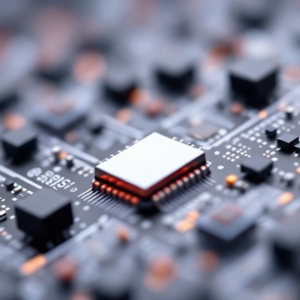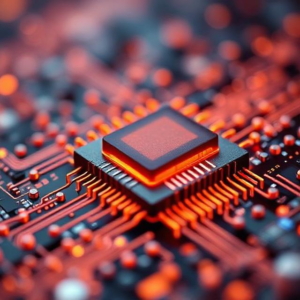1. What is Nanoelectronics?
Nanoelectronics is a field of electronics that deals with the design and use of extremely small electronic components—typically at the nanoscale, which means components that are billionths of a meter in size (around 1-100 nanometers).
At these tiny scales, electronics behave differently than when they’re at a normal scale. Scientists and engineers use these small components to create devices that are smaller, faster, and use less power.

2. Why Focus on Low Power Consumption?
Power consumption is a big concern in modern electronics because:
- Batteries in devices like smartphones, laptops, or wearables need to last longer.
- Energy efficiency is important in large-scale applications like data centers or Internet of Things (IoT) devices.
- Reducing power use means less heat generation and better performance.
So, designing low-power electronics is crucial to make devices more efficient, longer-lasting, and environmentally friendly.
3. How Nanoelectronics Helps with Low Power Consumption
Nanoelectronics helps reduce power consumption in several ways:
a. Smaller Transistors
- The transistor is a basic building block in electronics. It acts as a switch that controls the flow of electricity in a circuit.
- In traditional electronics, transistors are relatively large, but in nanoelectronics, transistors are smaller and more efficient.
- Smaller transistors mean they need less power to operate. Less power is required to switch them on and off, leading to reduced energy use.
b. Quantum Effects
- At the nanoscale, quantum mechanics come into play. This means electrons can behave in interesting ways that help reduce energy loss.
- Quantum tunneling (when electrons pass through barriers that would normally stop them) can allow circuits to be more energy-efficient, reducing the need for extra power.
c. More Efficient Materials
- Nanoelectronics uses special materials that are better at conducting electricity and can handle smaller currents without wasting energy.
- For example, materials like graphene and carbon nanotubes are super-efficient conductors and can help make devices use less energy while still delivering fast performance.
d. Lower Operating Voltage
- Nanoelectronics allows devices to operate at lower voltages. Lower voltage means that less energy is needed to power the device, contributing to low power consumption.
- As transistors get smaller, they can function at lower voltages without sacrificing performance.
4. Key Technologies in Nanoelectronics for Low Power
Several cutting-edge nano-scale technologies are specifically designed to reduce power consumption:
a. FinFET Transistors
- Traditional CMOS (Complementary Metal-Oxide-Semiconductor) transistors are being replaced with FinFET (Fin Field-Effect Transistor) technology.
- FinFETs have a 3D structure that allows them to operate more efficiently, reducing leakage current (unwanted power loss when the transistor is supposed to be off).
b. Quantum Dot Technology
- Quantum dots are tiny semiconductor particles that can be tuned to emit light or electrons in specific ways. In nanoelectronics, quantum dots can be used in displays and sensors, providing low-power solutions for these components.
c. Memristors
- Memristors are another emerging technology. These are resistors with memory—they can store information without needing power. This means that they can be used in memory devices that consume very little power compared to traditional memory.
d. Carbon Nanotubes
- Carbon nanotubes are extremely small tubes made of carbon atoms. They have excellent electrical conductivity, making them ideal for creating low-power transistors and circuits. Carbon nanotubes also generate less heat than traditional materials.
5. Examples of Low Power Nanoelectronics in Use
Here are some real-world applications of nanoelectronics for low power:
a. Smartphones
- Smartphones rely on power-efficient processors and sensors to conserve battery life. Nanoelectronics helps make these components smaller and more efficient, allowing smartphones to run faster with lower energy consumption.
b. Wearables (e.g., Smartwatches)
- Wearables like smartwatches need to operate for days without charging. Nanoelectronics allows these devices to use low-power chips and sensors, making them compact yet energy-efficient.
c. IoT Devices
- Internet of Things (IoT) devices like smart thermostats or security cameras need to be always connected, but they can’t consume too much energy because they often run on batteries.
- Nanoelectronics helps make these devices energy-efficient, allowing them to run on small batteries for a long time.
d. Data Centers
- Large data centers use massive amounts of energy to store and process data. Low-power nanoelectronics can help design chips that consume less power while still delivering high performance, reducing the overall energy use in these centers.
6. Advantages of Low Power Nanoelectronics
- Longer battery life: Devices like smartphones, laptops, and wearables can last longer without needing to recharge.
- Faster performance: Even though the power consumption is lower, devices can still run very fast.
- Less heat generation: Low power consumption means less heat is produced, which keeps devices cool and extends their lifespan.
- Energy savings: For large systems (like data centers or IoT networks), using nanoelectronics means less energy is required to power a huge number of devices, which is better for the environment and reduces costs.
7. Challenges
Despite the great potential, nanoelectronics for low power still faces some challenges:
- Manufacturing difficulties: Building nanoscale components is complex and expensive.
- Quantum issues: As components get smaller, quantum effects can sometimes make them behave unpredictably, leading to potential challenges in scaling them up.
- Heat dissipation: Even with low power, the heat generated by very dense circuits can still be a concern.
Conclusion
Nanoelectronics for low power consumption is all about making electronic components smaller, more efficient, and less power-hungry. By using tiny materials and advanced technologies like FinFETs, carbon nanotubes, and quantum dots, we can build faster devices with longer battery life and less energy waste. This is crucial for everything from smartphones to data centers, where we need to balance high performance with low power to create devices that are both powerful and efficient.











